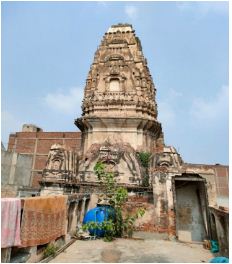Urban Conservation: A Transformational Vision for an Abandoned Hindu Temple in Lahore
Abstract
 Abstract Views: 0
Abstract Views: 0
Lahore is an ancient city known for its diverse culture, art, and history, which is nearly 2,000 years old. Before the partition of the subcontinent, Lahore served as a home not only to Muslims but also to Sikhs, Christians, Jains, Hindus, and other religions. There were many places of worship built for different religions at that time. After partition, the majority of the Hindus migrated to India and left behind their abandoned worship places, that is, temples. These temples were occupied by the Muslims who migrated to Lahore from India. With the passage of time, they have declined significantly and need proper measures for their preservation. These abandoned temples are one of the significant remains of Lahore’s rich cultural background. Therefore, it is imperative to conserve these structures. One of the historically significant temples is the Old Basuli Hanuman temple. This study mainly focuses on the conservation of this prestigious temple, located on Aibak Road adjacent to the new Anarkali Bazar. It attempts to identify the barriers to the conservation of Hindu temples and formulates strategies that can be used for their conservation. These may include the restoration or reconstruction of the temple back to its original identity or changing it to a completely different economically and aesthetically beneficial structure. Furthermore, this study aims to pave the way for the preservation not only of the Old Basuli Hanuman temple but also of other neglected heritage sites.
Downloads
References
Albers, G. (1989). Preservation and change in the focus of urban planning. The Old City, 2-3, 164–172.
Badawy, S., & Shehata, A. M. (2018). Sustainable urban heritage conservation strategies—case study of historic Jeddah districts. In Cities' identity through architecture and arts (pp. 83–97). Routledge.
Biswas, R. K. (1996). "Faster higher further!" Large construction sites of superlatives. City Building World, 132, 2746–2748.
Böhme, H., Koerte, A., Schott, D., Skroblies, H., Tjoa-Bonatz, M. L., & Toyka-Seid, M. (1998). Urbanization and old town renewal in Southeast Asia. Trialogue, 56, 4–7.
Chohan, A. Y., & Ki, P. W. (2005, October). Heritage conservation a tool for sustainable urban regeneration: A case study of Kaohsiung and Tainan, Taiwan (Paper presentation). 41st ISoCaRP Congress.
Danisworo, M., & Martokusumo, Widjaja (2002). The search for appropriate conceptual framework in urban heritage preservation and conservation: Discourse upon continuity and change in the Indonesian context (Working paper, Delft Technical University).
Elnokaly, A., & Elseragy, A. (2013). Sustainable heritage development: learning from urban conservation of heritage projects in nonwestern contexts. European Journal of Sustainable Development, 2(1), 31–31. https://doi.org/10.14207/ejsd.2013.v2n1p31
Feilden, B. M., & Jokilehto, J. (1998). Management guidelines for world cultural heritage sites. ICCROM.
Larkham, P. J. (1996). Conservation and the city. Routledge.
Setha, M. (2003). Social sustainability: People, history, and values. Getty Publications.
Silva, K. D. (2001). Preserving historic urban districts: Issues of culture change, stress, and culture-supportiveness. In M. Edge (Ed.), Old world ~ New ideas: Environmental and cultural change and tradition in a shrinking world (pp. 15–21). Environmental Design Research Association.
Silva, K. D. (2006). Conserving Asian urban heritage: The need for re-conceptualizing the value-based Management approach. In Asian Approaches to conservation (pp. 16–23). Chulalongkorn University.
Stovel, H. (1998). Risk preparedness: A management manual for world cultural heritage. ICCROM.
Strauss, A. L. (1961). Images of the American city. The Free Press of Glencoe.
UNESCO. (2003). Convention for the Safeguard of the Intangible Cultural Heritage. https://ich.unesco.org/en/convention
Yeoh, B. S., & Huang, S. (1996). The conservation-redevelopment dilemma in Singapore: The case of the Kampong Glam historic district. Cities, 13(6), 411–422. https://doi.org/10.1016/0264-2751(96)00028-5

Copyright (c) 2023 Asim Muhammad, Jarrar Haider, Saima Rafique

This work is licensed under a Creative Commons Attribution 4.0 International License.
JAABE follows an open-access publishing policy and full text of all published articles is available free, immediately upon publication of an issue. The journal’s contents are published and distributed under the terms of the Creative Commons Attribution 4.0 International (CC-BY 4.0) license. Thus, the work submitted to the journal implies that it is original, unpublished work of the authors (neither published previously nor accepted/under consideration for publication elsewhere). On acceptance of a manuscript for publication, a corresponding author on the behalf of all co-authors of the manuscript will sign and submit a completed Copyright and Author Consent Form.
Copyright (c) The Authors





